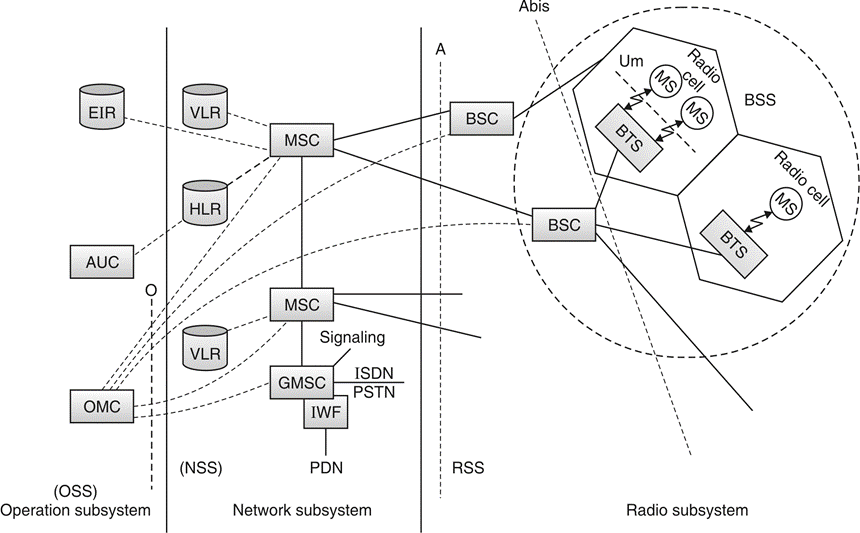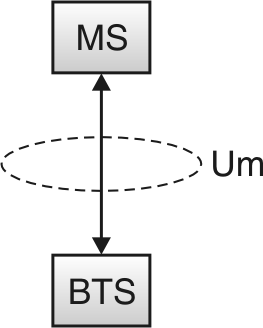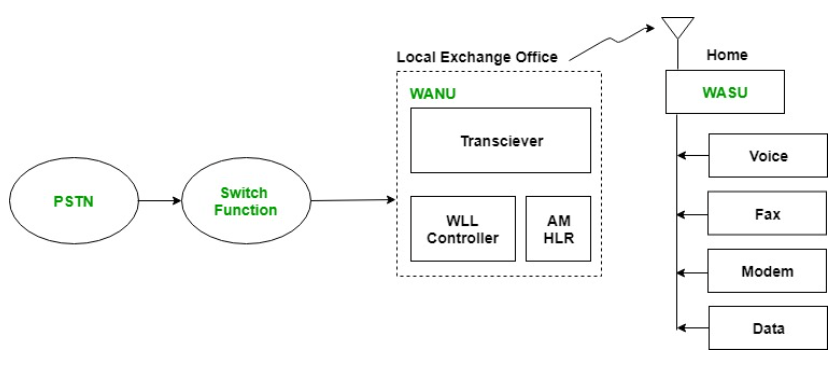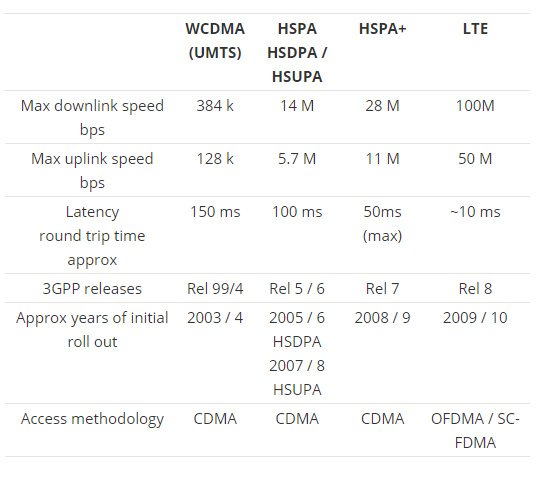Unit-5
GSM system for mobile Telecommunication
- GSM is one of the most successful and popular mobile telecommunication standards. Global System for Mobile communication (GSM) is a 2G communication standard with the frequency ranges of 900, 1800 and 1900 MHz.
- GSM has initially been deployed in Europe and its main aim is to provide a mobile system that can provide the voice service compatible to the other PSTN and ISDN systems.

Fig.1: GSM Architecture
A GSM system consists of three subsystems:
1.Radio Sub System (RSS)
2.Network and Switching Subsystem (NSS)
3.Operation Sub System (OSS)
Radio Sub System
In GSM network all radio specific entities are comprised in radio sub systems. RSS consists the two main entities as:
(i)Mobile Station (MS)
(ii)Base Station System
The basic function of RSS is to connect the mobile station to the network. The RSS can consist a number of Base Station Controller (BSC) and each BSC connects to the number of Base Transceiver Systems (BTS) and each BTS connects to a number of mobile stations (MS).
(i)Mobile Station (MS)
A Mobile Station (MS) consists of several functional groups.
(a)Mobile Terminal (MT)
Mobile Terminal offers common functions used by all services. MT transmits through the interface Um.
(b)TA (Terminal Adapter)
Terminal adaptation hides the radio specific characteristics.
(c)Terminal equipment (TE)
A user terminal through which the user receives and sends the data. It can be a headset, microphone etc.
(d)SIM (Subscriber Identity Module)
It is a card inserted into the MS. SIM uniquely identifies the user to the services, stores user parameters and enables the MS to connect to the GSM network.
(ii)Base Station Subsystem (BSS)
BSS have two main components:
(a)Base transceiver station
It connects to a number of mobile stations. The connection between the MS and BTS is established through the Um user interface. Main functions performed by BTS are as follows:
(i)Processing of signals
(ii)Formation of cells
(iii)Amplification of signals
(iv)Frequency hopping
(v)Channel coding and decoding
(vi)Encryption and decryption of data.

Fig.2: MS and BTS connection through Um in GSM cell
(b)Base station controller
It manages a number of BTSS. It uses the Abis interface to connect to various BTSs main functions performed by BSC are as follows:
(i)Processing of signals
(ii)Switching between BTSs
(iii)Controlling BTSs
(iv)Reserving radio frequencies
(v)Frequency hopping and paging.
(vi)Authentication, encryption and decryption of data.
Network and Switching Subsystem (NSS)
- NSS can be considered as the heart of the GSM system. The NSS connects the wireless network with standard public network.
- Switching, mobility management, interconnection to other network, system control is some main work of NSS.
The NSS consists of the following databases and switches:
(i)Mobile Services Switching Center (MSC)
- There are mainly high-performance digital ISDN switches. They used to set up the connections to other MSCs and to the BSCs over the A interface.
- The main aim of MSCs is to manage the various BSCs in a geographical region. The various functions performed by MSC are as follows:
(i)Establish the connections to other fined network, such as PSTN and ISDN via Gateway MSC (GMSC) or Interworking functions (IWF).
(ii)Handles all signaling needed for connection setup, connection release and handover of different connections to the other MSCs.
(iii)Call monitoring of MS.
(iv)Supplementary service support such as call forwarding multi-party calls.
(ii)Gateway Mobile Service Switching Centre (GMSC)
This is a MSC which handles connections to other networks like ISDN, PSTN, PSPDN.
(iii)Home Location Register (HLR)
- HLR is important database in a GSM system that stores all relevant information of user. It stores the Mobile Subscriber ISDN (MSISDN) number, subscribed services such as call forwarding, roaming, GPRS, subscriber’s ISMI, user’s location Area, Users current VLR and MSC status.
- A unique HLR record is maintained for each mobile user, which is updated on a real-time basis. HLR can manage data for huge number of customers with the help of highly specialized databases.
(iv)Visitor Location Register (VLR)
- VLR is a dynamic database which associated to each MSC.
- VLR is used to stores all important information needed for the mobile station users, such as the current location area (LA) information that is connected to MSC. If a new MS comes into other location area then VLR copies all relevant information of this user from HLR.
Operation Sub System (OSS)
OSS work for the operation and maintenance of the entire network. The main components of OSS are Operation and Maintenance Centre (OMC), Authentication Centre (AuC) and Equipment Identity Register (EIR).
(i)Operation and Maintenance Center (OMC)
- The OMC monitors and controls all other network entities over the O interface.
- Main functions of OMC are management of status reports of network entities, Subscriber security management, traffic monitoring and accounting and billing.
(ii)Authentication Centre (AuC)
- AuC is used by the HLR to authenticate the user, AuC is used to protect user identity and data transmission.
- The AuC used various algorithms for authentication as well as use the keys for encryption and generates the values needed for user authentication in HLR.
(iii)Equipment Identity Register (EIR)
- EIR works as the database for all International Mobile Equipment identity (IMEI), it stores all device identifications registered for this network such as the mobile equipment manufacturer and model.
- Stolen or malfunctioning mobile station can be locked by using the black list of EIR.
Key takeaway
- GSM is one of the most successful and popular mobile telecommunication standards. Global System for Mobile communication (GSM) is a 2G communication standard with the frequency ranges of 900, 1800 and 1900 MHz.
- GSM has initially been deployed in Europe and its main aim is to provide a mobile system that can provide the voice service compatible to the other PSTN and ISDN systems.
- General Packet Radio System (GPRS) is a packet-based data services for wireless communication.
- A packet radio principle is used to transfer subscriber data packet within GSM mobile station and external packet data network.
- Data is split and transmitted at sender node and reassembled at receiving end. GPRS support IP and X.25, these operate over cellular connection of a GSM.
- According to peter Rysavy, Rysavy Research 1998 GPRS network is as follows:

Fig.3: GPRS network (1)
- GPRS system has a base of GSM communication and somewhat of circuit switched phone connection, Short Message Service (SMS).

Fig.4: GPRS Network (2) (by Peter Rysavy)
Working of GPRS
- SGSN:
It manages to send and receive of packet data to and from MS. It is useful for keeping track of mobile devices within scope of service area. It works in mobility management subscribed user verification and provides data required for billing.
- GGSN:
It has vital role of routing information whichever is necessary for tunneling Protocol Data Unit (PDUs). To SGSN to Serve Distinct MS. It is on interface for external PDNs. i.e. public data units like internet and X.25.
Charging gateway
- It maintains log entries for activities like data being transfer, change in charging terms in peak/off to peak and vice-versa, end of session for GPRS etc.
- It has collection records related to GPRS, usage in buffering of data, storage, transfer of data.
GTP
GPRS tunneling protocol uses to encapsulate IP or X.25 packet which are transferred among SGSN and GGSN.
Key takeaway
GPRS provides many functions among several applications. These are listed below:
- Chat
- Information services as text or graphics.
- Still images.
- Moving images
- Web browsing
- Document sharing and remote collaborative working
- Audio reports
- Job dispatch
- Corporate email
- Vehicle positioning
- File transfer.
Enhanced Data rates for Global Evolution (EDGE) introduces a new modulation technique, as well as protocol enhancements for transmitting packets over the radio.
The use of the new modulation and the protocol enhancements, result in dramatically increased throughput and capacity gains enabling 3G services in the existing GSM/GPRS networks. No changes are needed to the existing core network infrastructure to support EDGE. This emphasizes the fact that EDGE is only an “add-on” for BSS.
For EDGE, nine Modulation and Coding Schemes (MCS) are introduced (MCS1 to MCS9) and optimized for different radio environment. Four EDGE coding schemes are using GMSK and five are using 8 PSK Modulation.
Up gradation to EDGE
- Mobile Station (MS) − MS should be EDGE enabled.
- BTS − HW supplied is Edge enabled.
- BSC − Definitions for EDGE timeslots need to be done in BSC.
- GPRS Support Nodes (GSNs) − Definitions for Edge need to be defined in GSNs.
- Databases (HLR, VLR, etc.) − No definition is required.
Benefits of EDGE
- Short-term benefits − Capacity and performance,
- Easy implementation on a GSM/GPRS network,
- Cost effective,
- Increases the capacity and triples the data rate of GPRS,
- Enables new multimedia services,
- Long-term benefit − Harmonization with WCDMA.
Key takeaway
- Streaming applications
- Very high-speed downloads
- Corporate intranet connections
- Quicker MMS
- Video phone
- Vertical corporate applications - Video conference, Remote presentations.
Cdma2000 specification was developed by the Third Generation Partnership Project 2
(3GPP2), a partnership consisting of five telecommunications standards bodies: ARIB
And TTC in Japan, CWTS in China, TTA in Korea and TIA in North America.
The evolution of cdma2000 1x is labeled cdma2000 1xEV. 1xEV will be implemented in
Steps: 1xEV-DO and 1xEV-DV. 1xEV-DO stands for "1x Evolution Data Only". 1xEVDV
Stands for "1x Evolution Data and Voice". Both 1xEV cdma2000 evolution steps will
Use a standard 1.25 MHz carrier.
Technical Summary for CDMA 2000

It is the circuit line from subscriber phone to the local central office. As this scheme is cost expensive if the users are less as we may have in rural and remote areas. The expenditure to this line system is more hence the wireless local loop system came into existence. The wireless system uses wireless links to connect the wireless local loop to the local central office.

Fig 5 WLL Architecture
Components of WLL are
i) PSTN: It is Public Switched Telephone Network. It has all the circuit switched telephone network.
Ii) Switch Function: It switches PSTN among various WANU.
Iii) WANU: It is called as wireless access network unit present at local exchange office connecting all local WASU. It consists of WLL controller, HLR and access manager.
Iv) WASU: It is called as wireless access subscriber units. The subscriber is provided with this at his place.
Key takeaway
It has low cost. It is secure due to digital encryption technique.
5.6.1 IMT 2000
It is called international mobile telecommunication 2000. For indoor and outdoor operation, it has high data rate. It is for symmetrical and asymmetrical data transmission. It can be implemented for circuit switched and packet switched services. It can be implemented for multimedia services.
5.6.2 UMTS
It is called as Universal Mobile Telecommunication Framework. It is in succession to the 3G GSM. It has mainly adapted from CDMA. It helps in speed boost from 2G standard of transmission speed. It employs WCDMA. It has rate of 2Mbps. It has low cost and high information rate.
Key takeaway
It is more expensive than GSM.
It was evolved as the 4G successor in the mobile communication with higher data rate. It has low operating cost. It is known as Long term evolution. It provides 4G level of performance. The 4G LTE comparison with other mobile communications is shown below.

Fig 6: Comparison of LTE with other mobile communication systems
The new features of LTE were later introduced. It was upgraded such that it is compatible with OFDM, MIMO. TO provide high speed and data rate the functions which were handled by the core network were transferred to the periphery. 4G LTE has become the main mobile communication technology. The older generations were mainly based on the voice and 4G LTE when evolved changed it to the mobile data connectivity.
Key takeaway
4G LTE has become the main mobile communication technology. The older generations were mainly based on the voice and 4G LTE when evolved changed it to the mobile data connectivity.
The communication between the satellite and the earth is established using radio station on earth. The other way to make this possible through artificial satellites. The mobile satellite communication can be classified
- Geostationary Earth Orbit (GEO): As the GEO has high range so only three GEO satellites can cover the complete earth. There is no need for antenna adjustments and they have high life time.
- Medium Earth Orbit (MEO): They require highest number of satellites.
- Low Earth Orbit (LEO): There is low transmission power of the antennas and are used for smaller foot prints.
- Highly Elliptical Orbit (HEO): It has the lowest altitude.
The table shown below mentions the requirements of the GEO, LEO, MEO to be established.

Key takeaway
In MEO the satellites require high transmission power. For GEO high transmission power is required.
These are wireless ad hoc networks having many mobile devices which form a network. They form the network independently. There is wireless connection between all the mobile nodes. These nodes can move as there are changes in the network topology.

Fig 7: Mobile ad hoc network
The node MS2 changes its connectivity from MS3 to MS4. In this case the other networks have to change the path /topology for transferring data to MS2. IN these types of architecture, the nodes are free to move. The MS connected in the network uses batteries as the source of energy.
Key takeaway
They are useful in defence, virtual navigation. These networks are not completely secure in terms of privacy.
It is a high-speed wireless communication which uses LEDs. It is similar to the Wi-Fi but Li-Fi allows bidirectional transmission of light. These systems make use of visible light spectrum. The system requires photodiodes and light source as it uses light as a medium for data transmission. They emit light according to the amount of current flowing through them. The LED bulbs having data passes it to the photodiodes at very high speed. The light is received by photodiode and then it is demodulated.
It is a wireless protocol like Bluetooth which is of a short range. The UWB has a very high operating frequency in range of GHz. These are presently used to discover any location and previously it was used in military radars. They use less power and are more precise. They work in a very wide range of frequency spectrum and billions of pulses are transmitted which are recovered by the receivers. If the smart phones having this feature are near in any surrounding, they can measure their exact distance and it is called as Time of Flight.
The mobile data networks are the services which are in relation to the data services having wide coverage area. This area can be a campus or some local area. These networks are classified in three categories such as
i) Independent Mobile Data: As the name suggests they are independent networks having their own infrastructure and spectrum services. On the basis of operating frequency band, they can be categorised as independent spectrum and second group of independent mobile data networks.
Ii) Shared Mobile Data: The network here shares the part of its infrastructure with the network which is already existing. This service can use the unused voice channel. This scheme shares the infrastructure which already exists. There is no independent air interface present.
Iii) Overlay Mobile Data: The data service will not only make use of the spectrum allotted for another service but also the MAC frames and air interface of an existing voice oriented digital cellular system GPRS and GSM’s
Key takeaway

It is called international mobile telecommunication 2000. For indoor and outdoor operation it has high data rate. It is for symmetrical and asymmetrical data transmission. It can be implemented for circuit switched and packet switched services. It can be implemented for multimedia services.

Fig 8 IMT Family structure
- 4G takes on a number of equally true definitions, depending on whom you are talking to. In simplest terms, 4G is the next generation of wireless networks that will replace 3G networks sometimes in future.
- In another context, 4G is simply an initiative by academic R&D labs to move beyond the limitations and problems of 3G which is having trouble getting deployed
And meeting its promised performance and throughput.
- In reality, as of first half of 2002, 4G is a conceptual framework for or a discussion point to address future needs of a universal high speed wireless network that will interface with wire line backbone network seamlessly.
- 4G is also represents the hope and ideas of a group of researchers in Motorola, Qualcomm, Nokia, Ericsson, Sun, HP, DoCoMo and other infrastructure vendors who must respond to the needs of MMS, multimedia and video applications if 3G never materializes in its full glory.
Need of 4G:
- Firstly, 3G’s maximum data transfer rate of 384 kbps to 2 mbps is much slower than 20mbps to 100mbps of 4G.
- With its use of existing technologies & communication standards, 4G present a comparably inexpensive standard.
- 4G will utilize most of the existing wireless communication infrastructure
Specification:
- 4G can provide 10 times increase in data transfer over 3G.
- This speed can be achieved through OFDM.
- OFDM can not only transfer data at speed of more than 100mbps, but it can also eliminate interference that impairs high speed signals.
Applications:
- 4G will provide for a vast no. Of presently nonexistent application for mobile devices.
- 4G device will differ from present day mobile device in that there will be navigation menus.
- 4G will provide a seamless network for users who travel & required uninterrupted voice/data communication.
Technique used in 4G:
- OFDM
- USB (Ultra Wide Band)
- Millimeter wireless.
- Smart Antennas
- Long term power prediction.
- Scheduling among users.
- Adaptive modulation and power control.
Key takeaway
- Support for interactive multimedia voice, streaming video, internet & other broadband services.
- IP based mobile system.
- High speed, high capacity & low cost per bit.
- Global access, service portability & scalable mobile services.
- Better scheduling and call admission control technique.
- Ad-hoc & multi-hop network.
- Better spectral efficiency.
- Seamless network of multiple protocols & air interfaces.
Reference:
1. T.S. Rappaport, “Wireless Communication-Principles and practice”, Pearson
Publications, Second Edition.
2. Misra, Wireless Communication & Network: 3G & Beyond, McGraw Hill Education
3. Jaganathan, Principles of Modern Wireless Communication System, McGraw Hill Education
4. Upena Dalal, “Wireless Communication and Networks”, Oxford Press Publications.
5. T L Singal, “Wireless Communications”, McGraw Hill Education.